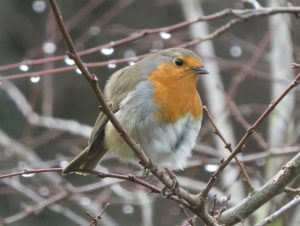At this time of year robins appear on our Christmas cards and are one of the commonest birds in our gardens. Their large eyes, colourful red breast and confiding nature have made them Britain’s favourite bird and yet there is more to robins than their popular image suggests.
Unlike most birds, robins sing almost all the year round, only falling silent when they moult in July and early August. They are also unusual in that both the males and females sing in winter. This is because each robin holds its own winter feeding territory with its song. During the breeding season only the males sing, switching from their subdued winter song to a louder, up-tempo song, delivered with gusto.
At the end of winter, female robins either combine their territory with a neighbouring male to create a breeding territory or abandon their winter territory and move away in search of a suitable mate. When the female is nest building and egg laying the male may provide up to a third of her food. This courtship feeding is important because it allows her to produce a larger clutch of eggs and replenish some of the nutrients she lost through egg laying (a full clutch of eggs could weigh as much as 90% of the female’s body weight).Robins have such strong parenting instincts that they have been recorded feeding the chicks of several other species including blackbirds and song thrushes.
British robins are famously tame, appearing close by when we go into the garden or walk through woodland. We assume this is because they are friendly birds. The real reason is that they think we are pigs, or to be more precise wild boar. In their natural woodland home, robins follow wild boar and large herbivores so that they can feed on the invertebrates exposed by the activities of these animals.
Robins frequently appear on our Christmas cards. This tradition goes back to 1840 when the penny post first began. To promote the service, customers were encouraged to send greetings cards to friends and family. The postmen, who delivered these cards wore red uniforms and were nicknamed ‘robins’. Shortly afterwards, Christmas cards in which robins dressed as postmen with cards in their beaks appeared. This began the tradition of robins on Christmas cards that continues to this day.
However, there is a darker side to them.
Robins are fiercely territorial and the red breast that we find so attractive is actually an aggressive signal intended to intimidate any other robin that comes into their territory. Some robins are so aggressive that they will even attack a single red feather. For this reason, juvenile robins are brown and only acquire a red breast at their first moult. Up to 10% of males and 3% of females may die due to injuries sustained in fights.
In December 2022, recently-published research found that human-made noise pollution causes robins living in rural areas to become more physically aggressive.
The study, published in the journal Behavioral Ecology and Sociobiology, investigated the behaviour of male European robins. Scientists from Anglia Ruskin University (ARU) in the U.K. and Koç University in Turkey measured aggression towards an intruder by using a 3D model of a robin. The model was accompanied by recordings of robin songs, while additional traffic noise was added through a separate speaker nearby.
By recording the birds’ behaviour during interactions with the simulated intruder, researchers found that urban robins typically displayed more physical aggression than rural robins. However, rural robins became more aggressive with the addition of traffic noise. The scientists believe that physical displays of territoriality increase because traffic noise interferes with robins’ signalling behaviour using song.
During tests on urban robins, which are already living in noisier habitats, the simulated traffic noise did not affect levels of physical aggression, but they adapted to the additional noise by reducing their call rate.
The researchers suspect that urban robins have learned to “sit out” temporary increases in noise whereas rural robins have not, and rural robins instead compensate with increased physical aggression.
Dr. Caglar Akcay, senior lecturer in behavioral ecology at Anglia Ruskin University (ARU) and the senior author of the study, said, “We know that human activity can have a significant impact on the long-term social behaviour of wildlife, and our results show that human-produced noise can have a range of effects on robins, depending on the habitat they live in.
“In normally quiet surroundings, we found that additional traffic noise leads to rural robins becoming more physically aggressive, for instance approaching the model bird more closely, and we believe this is because the noise is interfering with their communication.
“The chronic high levels of noise that exist day and night in urban habitats, such as from traffic or construction equipment, may permanently interfere with the efficient transmission of acoustic signals and this is likely to be the key reason why urban robins are typically more aggressive than rural birds. It should be stressed that physical aggression is a risky behaviour for small birds like robins and is likely to have health consequences.”
Lead author Çağla Önsal, who carried out the research during her studies at Koç University, added, “Signals are extremely useful because they can deter an intruder without a fight that may be costly to both the territory owner and the intruder, but if the songs can’t be heard by the intruder the robins may have to resort to physical aggression. However, this not only risks injury but displays of aggression can also draw attention to predators, such as sparrowhawks.”
Sources:
https://phys.org/news/2022-12-traffic-noise-rural-robins-aggressive.html
More information: Çağla Önsal et al, Aggression and multi-modal signaling in noise in a common urban songbird, Behavioral Ecology and Sociobiology (2022). DOI: 10.1007/s00265-022-03207-4
Words by Keith Wakerley and Chris Overton.
Image copyright Keith Wakerley
To download a PDF version of this article, please click here

